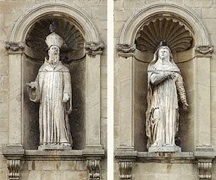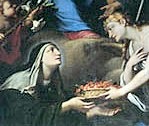

Blessed Sperandio and Gennara (15th January)

Statues (17th century) of Blessed Sperandio and Blessed Gennara
Facade, Santa Maria del Prato
In his “Vite de’ Santi e Beati dell’ Umbria” (1647-61) Ludovico Jacobili recounts that the Blessed Sperandio and the Blessed Gennara were married to each other but chose to live separate lives in religious institutions:
-
✴The Blessed Sperandio took vows at the Abbazia di San Pietro, Gubbio and is securely documented as its abbot for a period up to his death in 1260. He took a close interest in the establishment of nunneries:
-
•The nunnery of San Sperandio in Gubbio, which he probably established, was dedicated to him (as San Sperandio, later absorbed by the Monastero del Santo Spirito).
-
•He was instrumental in helping the Blessed Santuccia (below) to establish her nascent order of nuns that became the Serve di Maria (servants of Mary). The nunnery that she established at Perugia was dedicated to him (again, as San Sperandio).
-
✴The Blessed Gennara joined the nunnery of Santa Maria del Paradiso and became its abbess before her death in 1293. According to tradition, a small church near the nunnery (on the later site of Santa Maria del Prato) stood on the site of what had been the marital home. According to a memorial written in 1631, Pope Sixtus IV gave permission for the relics of the Blessed Gennara to be moved to the nuns’ new home in Santo Spirito in 1482. They were still there in 1856 but were subsequently moved to the Cappella del Santissimo Sacramento of the Duomo.
Blessed Santuccia Carabotti (21st March)

Panel (ca. 1760) of Blessed Santuccia by Giuseppe Reposati,
Raccolta d’ Arte della Cattedrale, Gubbio
Santuccia was born in Gubbio in ca. 1240, married and had a daughter who died in childhood. She and her husband then agreed to separate and enter religious life under the spiritual guidance of the Blessed Sperandio (above). Santuccia’s husband became a monk at San Pietro while she obtained the permission of the bishop of Gubbio to found a new Benedictine nunnery on a hillside (presumably near Gubbio) that belonged to the “sons of Ugone”. She adopted a constitution that the Blessed Sperandio devised, which stressed that the nuns were to live in poverty.
After the death of the Blessed Sperandio, Santuccia continued to develop her new congregation. The nuns were formally Serve di Maria (servants of Mary), but they were often known as the Santucce. Santuccia established nunneries at Perugia (San Sperandio), Cagli and Rimini in the early 1260s and at Città di Castello (Monstero delle Santucce) in ca. 1271.
In 1265, Santuccia fell foul of the new abbot of San Pietro, Giovanni, who excommunicated her. Fortunately, she had influential supporters, and Pope Clement V took the nuns into papal protection. The Templars gave them the church of Santa Maria in Julia (later Sant’ Anna dei Funari), Rome, and this became their mother house. Santuccia died there in 1305, by which time her order encompassed some 25 nunneries.
Blessed Sperandia (11th September)

Miracle of the Cherries (1683) by Pier Simone Fanelli (detail)
Santa Sperandia, Cingoli
The Blesed Sperandia (died 1276) is sometimes claimed as a descendant of St Ubaldus or as the sister of the Blessed Sperandio (above), but neither assertion is backed by documents. She lived as a wandering hermit for many years before retiring to the Monastero di San Michele, Cingoli. She was venerated for her miraculous powers: the detail above shows an angel appearing to her in January with a bowl of cherries. She had become the abbess of the nunnery by the time of her death, and was later adopted as the patron saint of Cingoli. The nunnery there is now dedicated to her, and her relics are preserved in its church.
Read more:
The controversy of Santuccia Carabotti and the abbot of San Pietro are described in pp 187-91 of:
K. Gill, “Scandala: Controversies Concerning Clausura and Women’s Religious Communities in Late Medieval Italy”, in :
S. Waugh and D. Diehl (eds), “Christendom and its Discontents: Exclusion, Persecution, and Rebellion (1000-1500)”, (1996) Cambridge
For the Blessed Sperandio and the Blessed Gennara, see p. 167 in:
M. Ambrogi et al. (Eds), “Francesco Borromini e la Chiesa della Madonna del Prato: Francesco Borromini e la Chiesa della Madonna del Prato”, (2005) Città di Castello
Return to Saints of Gubbio.

